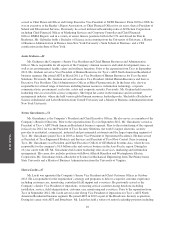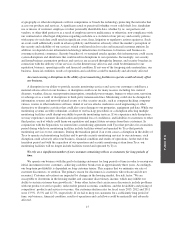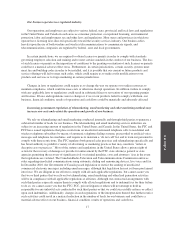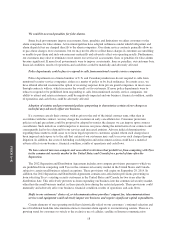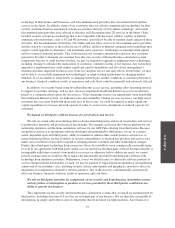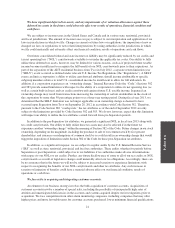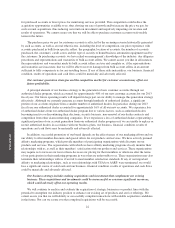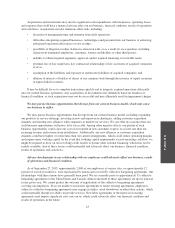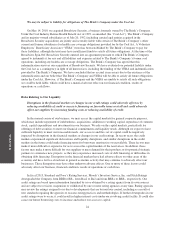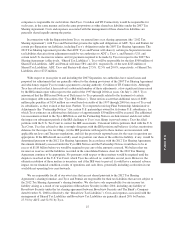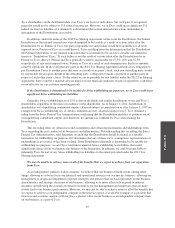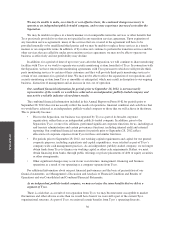ADT 2013 Annual Report Download - page 84
Download and view the complete annual report
Please find page 84 of the 2013 ADT annual report below. You can navigate through the pages in the report by either clicking on the pages listed below, or by using the keyword search tool below to find specific information within the annual report.
FORM 10-K
other difficulties our providers face may have negative effects on our business. We exercise little control over our
suppliers, which increases our vulnerability to problems with the products and services they provide. Any
interruption in supply could cause delays in installations and repairs and the loss of current and potential
customers. Also, if a previously installed component were found to be defective, we might not be able to recover
the costs associated with its repair or replacement across our installed customer base, and the diversion of
technical personnel to address the defect could materially and adversely affect our business, financial condition,
results of operations and cash flows.
We are exposed to greater risks of liability for employee acts or omissions or system failure, than may be
inherent in other businesses.
If a customer or third party believes that he or she has suffered harm to person or property due to an actual
or alleged act or omission of one of our employees or security system failure, he or she (or their insurers) may
pursue legal action against us, and the cost of defending the legal action and of any judgment against us could be
substantial. In particular, because our products and services are intended to help protect lives and real and
personal property, we may have greater exposure to litigation risks than businesses that provide other consumer
and small business products and services. Substantially all of our customer contracts contain a series of risk-
mitigation provisions that serve to limit our liability and/or limit a claimant’s ability to pursue legal action;
however, in the event of litigation with respect to such matters, it is possible that these risk-mitigation provisions
may be deemed not applicable or unenforceable and, regardless of the ultimate outcome, we may incur
significant costs of defense that could materially and adversely affect our business, financial condition, results of
operations and cash flows.
Certain providers of Internet access may block our services or charge their customers more for using our
services, or government regulations relating to the Internet could change, which could adversely affect
our revenue and growth.
Our interactive and home automation services are accessed through the Internet and our security monitoring
services are increasingly delivered using Internet technologies. Users who access our services through mobile
devices, such as smart phones and tablets, must have a high-speed connection, such as Wi-Fi, 3G or 4G, to use
our services. Currently, this access is provided by companies that have significant and increasing market power
in the broadband and Internet access marketplace, including telephone companies, cable companies and wireless
companies. These providers could take measures that affect their customers’ ability to use our products and
services, such as degrading the quality of the data packets we transmit over their lines, giving those packets low
priority, giving other packets higher priority than ours, blocking our packets entirely or attempting to charge their
customers more for using our products and services. Some of these providers could also offer products and
services that directly compete with our own offerings, which could potentially give them a competitive
advantage. These actions could decrease the demand for our products and services and increase our cost of doing
business.
In the United States, there continues to be some uncertainty regarding whether suppliers of broadband
Internet access have a legal obligation to allow their customers to access services such as ours without
interference. In December 2010, the FCC adopted net neutrality rules that would protect services like ours from
such interference by making it more difficult for broadband Internet access service providers to block, degrade or
discriminate against our services. These rules apply to wired broadband Internet providers, but not all of the rules
apply to wireless broadband service. Several parties have sought judicial review of the FCC’s net neutrality rules,
including an action brought against the FCC in the U.S. Court of Appeals for the District of Columbia Circuit.
These appeals are currently pending. We cannot assure that current net neutrality rules will not change in the
future. Interference with our services or higher charges to customers by broadband service providers for using
our products and services could cause us to lose existing customers, impair our ability to attract new customers
and materially and adversely affect our business, financial condition, results of operations and cash flows.
20


